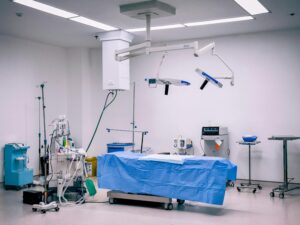Cleanroom assembly is a critical procedure that guarantees maximum environmental purity during the fabrication of sensitive products. This controlled location is essential for avoiding corruption and ensuring quality in high-value industries.
How Cleanroom Assembly Improve Product Safety and Inspection Outcomes
Cleanroom assembly provides an invisible shield that protects the most sensitive elements from their most silent enemy: contamination. Its main value lies in the creation of a vigorous fence against agents that can compromise the functionality or sterility of fabrication.
The connection between an examined area and product security is straight and undeniable. A site with a checked particle calculation diminishes the threats of corruption:
- Physical. Fibers, dust, or metals can disturb accurate machines or, in the case of an implantable device, cause adverse responses in the human body.
- Chemical. Organic vapors or aerosolized molecules that could accumulate on many surfaces, changing their configuration or functionality.
- Microbiological. Bacteria, viruses, fungi, and spores represent the most serious threat to the manufacture of sterile medical devices or other solutions.
Beyond protection, this level of pollution control thoroughly prepares any operation for a regulatory audit.
Integral Union: Environmental Inspection, Prevention, and Audits
These three columns form an accurate cycle where every element reinforces and validates the others, creating a solid scheme that guarantees quality. Furthermore, the relationship between these aspects is direct and symbiotic, as we will see below:
Environmental Control as a Foundation
Strict monitoring of parameters (particles, temperature, humidity, airflow) in an ISO Class 7 facility is not an end in itself. It is the active foundation that establishes the bounds within which the process is under control. This is the first link in the chain.
Prevention as an Action
Contamination control protocols (sterilized clothing, hygiene procedures, material handling) are the tangible actions within a controlled atmosphere. In this case, the goal is to maintain it stable and inhibit the introduction of contaminants.
Audit as a Verification
Planning for a regulatory audit is the natural outcome of successfully applying and recording a cleanroom assembly. Thus, inspectors look for documentary signs that the company is maintaining room control and following prevention protocols.
Up-to-date cleanroom validation, location monitoring records, and staff training reports are the tangible proof that convinces an auditor that the system is preventive and reliable.
In other words, strict environmental control enables effective pollution prevention. Together, they generate the documentation and objective evidence that demonstrates compliance during an audit.
You cannot be ready for a scrutiny without first having the two preceding elements under control. The inspection, therefore, is not a unique episode, but rather the external certification of a scheme that already functions accurately.
Advantages of operating with an approved and validated cleanroom
A clean area offers many benefits, guaranteeing obedience, raising product quality, and caring for patient safety through severe and legitimate contamination monitoring:
- Guaranteed regulatory compliance. Passes audits from relevant organizations (such as FDA, EMA, or ISO) by showing whole site control, evading costly rejects or downtime.
- Superior and consistent product quality. Diminishes defects and variations by eradicating the danger of contamination by particles or microorganisms, certifying uniform, high-yield batches.
- Protecting patient safety. In sectors such as medical device development, it is the first line of defense to stop infections or failures in sterile or implantable products, protecting the health of the end user.
- Operational efficiency and waste reduction. Process standardization within a controlled zone decreases inaccuracies, delays, and discarding, improving material use and manufacturing time.
- Documented cleanroom validation. Having a formal certification delivers a powerful marketing and trust instrument for clients and partners, showing a tangible commitment to distinction and finest practices.
Consequently, with continuous monitoring data and documented protocols, it demonstrates robust procedural control. Hence, this turns into positive inspection results, as organizations see a precautionary, not just corrective, system.
Beyond the Walls: Cleanroom Protocols and Personnel Practices
The physical infrastructure of a clean room, while vital, is inoperable without the human element working under strict rules. The dress code protocol is the first and most decisive line of defense and must include the following elements:
- Wear aseptic garments. Personnel shall don specific coveralls, hoods, boots, gloves, and face masks made out of polypropylene or Tyvek, which will be able to trap particles generated from the body.
- Use a staggered dressing process. Workers dress in a particular order inside a compressed air shower or hall so that contamination is not carried into the clean space.
- Practice arduous hygiene. Hand washing before entry and after any act that could compromise the sterility of gloves shall be a strict rule.
- Movement and behavior. Actions are gentle and insignificant to avoid disrupting laminar airflows and agitating stable particles. Discourse should be rigorous to decrease aerosol projection.
The right treatment of gear and instruments follows the identical central code. As a result, anything entering the area must undergo a cleaning procedure in airlocks or transfer chambers. In this case, manufacturer treats it with an appropriate disinfectant.
These protocols, constantly reinforced through training, form the foundation of successful contamination control.
RexMed’s Cleanroom Capabilities for High-Compliance Assembly
In RexMed, as a specialized company, we have developed first-class facilities to meet the demand for cleanroom assembly. In this case, our capabilities allow us to meet the requests of the FDA and other global agencies.
The core of our infrastructure includes areas that allow for invaluable operational flexibility, such as:
- ISO Class 7 room. In this case, this is the central zone for the most critical labor. With firm bounds on particulate matter, this class is the standard for the final making of equipment that must keep a sterile or aseptic condition.
- ISO Class 8 room. This is for processes in sanitized rooms that need a high level of sanitation but not the absolute sterility of a higher-classified place. Thus, it acts as an intermediate barrier of protection.
Important sectors, such as medical device manufacturing, high-end electronics, and aeronautics, rely on these well-ordered environments to confirm consistent, contamination-free results.
Understanding their procedures is not just a technical issue, but an obligation to guarantee quality and regulatory compliance.
Complex processes that RexMed performs on medical products
Within these rooms, RexMed performs complex actions for a diversity of medical products. Likewise, the company’s team of expert technicians is in charge for the assembly and packaging of:
- Sterile intravenous (IV) sets.
- Parenteral nutrition bags and solutions.
- Surgical and procedure kits.
- Custom assemblies that require aseptic conditions.
Furthermore, every project experiences demanding sanitized area validation, which includes particle accreditation, laminar airflow testing, differential pressure recovery, and environmental microbiological observation.
This documentation also guarantees clients that they receive products manufactured in a zone with demonstrable and audited control, mitigating risks and ensuring compliance.
The cleanroom assembly represents a tactical choice that goes beyond operating costs. It is therefore a venture in quality, safety, and reliability.






